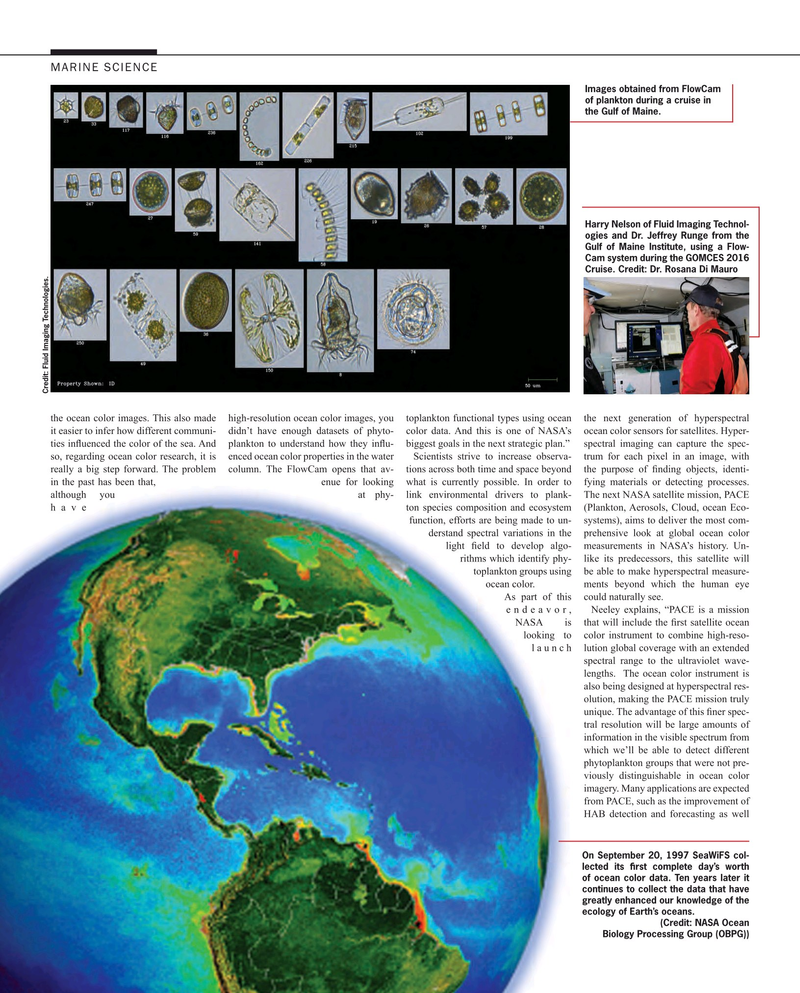
Page 52: of Maritime Reporter Magazine (November 2016)
Workboat Edition
Read this page in Pdf, Flash or Html5 edition of November 2016 Maritime Reporter Magazine
MARINE SCIENCE
Images obtained from FlowCam of plankton during a cruise in the Gulf of Maine.
Harry Nelson of Fluid Imaging Technol- ogies and Dr. Jeffrey Runge from the
Gulf of Maine Institute, using a Flow-
Cam system during the GOMCES 2016
Cruise. Credit: Dr. Rosana Di Mauro
Credit: Fluid Imaging Technologies.
the ocean color images. This also made high-resolution ocean color images, you toplankton functional types using ocean the next generation of hyperspectral it easier to infer how different communi- didn’t have enough datasets of phyto- color data. And this is one of NASA’s ocean color sensors for satellites. Hyper- ties in? uenced the color of the sea. And plankton to understand how they in? u- biggest goals in the next strategic plan.” spectral imaging can capture the spec- so, regarding ocean color research, it is enced ocean color properties in the water Scientists strive to increase observa- trum for each pixel in an image, with really a big step forward. The problem column. The FlowCam opens that av- tions across both time and space beyond the purpose of ? nding objects, identi- yp g p, in the past has been that, enue for looking what is currently possible. In order to fying materials or detecting processes. link environmental drivers to plank- at phy- although you although you at phy- link environmental drivers to plank- The next NASA satellite mission, PACE ton species composition and ecosystem have have ton species composition and ecosystem (Plankton, Aerosols, Cloud, ocean Eco- function, efforts are being made to un- function, efforts are being made to un- systems), aims to deliver the most com- derstand spectral variations in the derstand spectral variations in the prehensive look at global ocean color light ? eld to develop algo- light ? eld to develop algo- measurements in NASA’s history. Un- rithms which identify phy- rithms which identify phy- like its predecessors, this satellite will toplankton groups using toplankton groups using be able to make hyperspectral measure- ocean color. ocean color. ments beyond which the human eye
As part of this As part of this could naturally see.
endeavor, endeavor, Neeley explains, “PACE is a mission
NASA is NASA is that will include the ? rst satellite ocean looking to looking to color instrument to combine high-reso- launch launch lution global coverage with an extended spectral range to the ultraviolet wave- lengths. The ocean color instrument is also being designed at hyperspectral res- olution, making the PACE mission truly unique. The advantage of this ? ner spec- tral resolution will be large amounts of information in the visible spectrum from which we’ll be able to detect different phytoplankton groups that were not pre- viously distinguishable in ocean color imagery. Many applications are expected from PACE, such as the improvement of
HAB detection and forecasting as well
On September 20, 1997 SeaWiFS col- lected its ? rst complete day’s worth of ocean color data. Ten years later it continues to collect the data that have greatly enhanced our knowledge of the ecology of Earth’s oceans. (Credit: NASA Ocean
Biology Processing Group (OBPG))
MR #11 (50-57).indd 52 11/3/2016 5:39:04 PM

 51
51

 53
53
